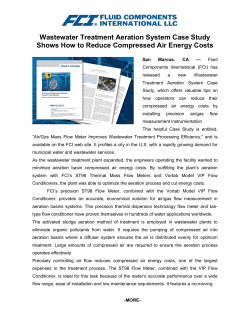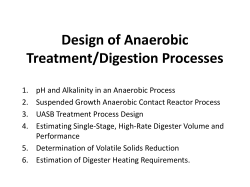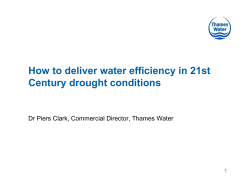
The Wastewater Treatment Process Callala Wastewater Treatment Plant -
Callala Wastewater Treatment Plant The Wastewater Treatment Process Callala Wastewater Treatment Plant - OFFICIALY OPENED – 10th AUGUST 1999 The Callala/Currarong wastewater collection and sewage reticulation system comprises of 55 kms of sewer mains and 13 pumping stations servicing the communities of Callala Beach/Bay, Myola and Currarong. Treatment Process The Callala Sewage Treatment Plant uses advanced physical, biological and mechanical processes to treat the incoming wastewater. Treatment is highly automated and can be remotely monitored outside usual business hours. The type of process is an Intermittent Decanted Extended Aeration (IDEA) process with biological nitrogen removal and options for a two stage phosphorus removal. The IDEA process is an activated sludge process for treatment of sewage liquid and stabilization of the sewage solids in the presence of oxygen. The treatment process is broken into three stages: 1. Primary treatment 2. Secondary treatment 3. Tertiary treatment The Wastewater Treatment Process – Shoalhaven Water, South Coast NSW Australia Preliminary/Primary Treatment: Incoming wastewater (Influent) enters the treatment plant at the Inlet Works. Here, the sewage passes through fine screens to remove non-biodegradable material such as plastics, cotton tips and sanitary products. The influent volume is then measured by an inline flume and ultra sonic sensor for the daily summary of data. Next the influent drops into a circular aerated Grit chamber for removal of grit, sand, rocks etc by way of a forced air vortex causing the material to spiral to the centre of the tank for air assisted removal. Screenings and grit are deposited into a concrete trench for offsite landfill. The wastewater then makes it way via channels and pipes to the next stage. Secondary Treatment (IDEA): After leaving the Inlet Works the effluent enters the Port Macquarie Tank* for Secondary treatment which is known as the Intermittently Decanted Extended Aeration (IDEA) phase which removes nutrients such as nitrogen and phosphorus and reduces Biochemical Oxygen Demand (BOD5). This process converts non-settleable organic solids to settleable solids and the separation of those from the liquid. Note: (BOD5) Biochemical Oxygen Demand – This is the amount of oxygen required by bacteria for biochemical oxidation (decomposition) of wastewater in a given time at a standard temperature, usually 5 O days at 20 C. *The Port Macquarie Tank was so named due to it being developed in Port Macquarie. The secondary process has three phases: Aeration Settling Decanting The Wastewater Treatment Process – Shoalhaven Water, South Coast NSW Australia Aeration Surface Aerators vigorously mix the incoming effluent with the activated sludge (aerobic bacteria) keeping it in suspension in the presence of supplied oxygen. Micro-organisms in the sludge use the organic material in the effluent as a food source for normal life functions and synthesis of new bacterial cells. Alum can be added to help remove phosphorus and enhance settlement. The Alum bound phosphorus salts sink to the bottom of the tank along with other solids. Also whilst aerating a quantity of Waste Activated Sludge or MLSS is removed and pumped to the Sludge Lagoons. “Nitrification” occurs during this stage (aeratrion/mixing) which is the oxidation of ammonia to nitrite. Note: MLSS – Mixed Liquor Suspended Solids Aeration Tank Settling The Aerators switch off and the effluent becomes still .Having no oxygen supply, the microorganisms use carbon in the organic matter as a food source, converting nitrates to nitrogen gas which is released to the atmosphere (“Denitrification”). During this phase the solids separate and settle from the liquid giving clarification to the upper part of the tank. The Wastewater Treatment Process – Shoalhaven Water, South Coast NSW Australia Decanting After settling, the clear wastewater is decanted from the tank into an automatically lowered centrally located trough. This Secondary treated effluent is piped into the Equalisation Basin for holding before its final tertiary treatment. Secondary Alum dosing can be used at this point for removal of phosphorus. Decant Trough Tertiary Treatment: The final stage of the process is called the tertiary treatment process. It is the disinfection (Chlorine Gas) and polishing (Pressure filtration) of secondary treated effluent resulting in the lowering of faecal Coliforms and BOD5 levels. Callala STP has six pressure filters which are filled with media composing of sand and anthracite. The secondary treated effluent is pumped through the filters where the processes of air scouring and backwashing are performed to produce tertiary treated effluent of the highest quality. After filtration the effluent is injected with Chlorine gas for disinfection, resulting in the reduction of the amount of pathogens (bacteria) which are requirements for public health reasons and licensing conditions. The Wastewater Treatment Process – Shoalhaven Water, South Coast NSW Australia Producing Recycled Water The highly treated water then enters the recycled water network known in the Shoalhaven as Reclaimed Effluent Management Scheme (REMS). Chlorine is added to the reclaimed water pumped from the Bulk storage dam to provide additional disinfection and to keep the recycled water pipes free of bacteria and ensure the recycled water meets the Australian Guidelines for Water Recycling. REMS (Reclaimed Effluent Management Scheme) This is a water recycling scheme aimed at long term re-use sustainability and maximising beneficial reclaimed water re-use. The scheme aims to reuse up to 80% of reclaimed water from a number of wastewater treatment plants in the area, substantially reducing the quantity of recycled water discharged to local estuarine and coastal waters. Filtered, disinfected reclaimed water is pumped to users of the REMS scheme from the Sewage Treatment Plants (STPs) through the distribution system. A 4ML distribution reservoir ensures a constant gravity supply to users when pump stations are not operating. Reclaimed water overflows from the reservoir to the bulk storage dam when irrigation demand is low and is pumped from the dam when demand is high. In prolonged wet weather periods, surplus water can be released through the outfall at Penguin Head. The Wastewater Treatment Process – Shoalhaven Water, South Coast NSW Australia The recycled water is carried to the local farms in a separate network of pipes that are colour coded (purple) so the farmers know whether they are using drinking water or recycled water. The treatment process has been influenced by the: Location of the plant Needs of the area serviced Technology available when the plant was built Biosolids Biosolids is the organic solid waste product that is a direct result from sewage treatment processes, and may be classified as suitable for beneficial use. Wastewater contains nutrient-rich solids, including human waste, which can be treated and re-used to improve soil for agriculture and grass. During the Aeration phase of Secondary treatment, activated sludge is pumped from the bottom of the Aeration Basin to the Sludge Lagoons. Matured sludge is then removed from the lagoon and processed through a dewatering machine called a “Centrifuge”. The end product “Biosolids” is left to dry on a prepared bed before testing and classification for its use. On average Callala STP produces 40-50 tonnes of dry Biosolids per year. The Wastewater Treatment Process – Shoalhaven Water, South Coast NSW Australia Interesting Facts: Callala Wastewater Treatment Plant is one of 14 wastewater treatment plants in the Shoalhaven. The plant treats and disinfects wastewater to a high tertiary standard then recycles most of it back to local farms for non-drinking irrigation purposes. It is also used on various sporting fields, golf courses and bowling green’s. Callala wastewater treatment plant is the Shoalhaven’s largest water recycling system. History and Features The treatment plant was purpose built to supply the REMS with a capacity of 6,000 equivalent persons. The treatment processes include primary screening, extended aeration, tertiary filtration and chlorine disinfection. The personnel who manage and operate the plant also collect and analyse water samples and conduct laboratory testing. The plant: Treats 0. 651 million litres of sewage a day(based on yearly average) Supplies 2500 million litres of highly treated recycled water a year (this is a combined volume discharged to REMS from the four treatment plants connected to the scheme) Contact details: Shoalhaven Water 1300 66 22 46 water@shoalhaven.nsw.gov.au www.shoalwater.nsw.gov.au PO Box 42 NOWRA NSW 2541 The Wastewater Treatment Process – Shoalhaven Water, South Coast NSW Australia
© Copyright 2025





















